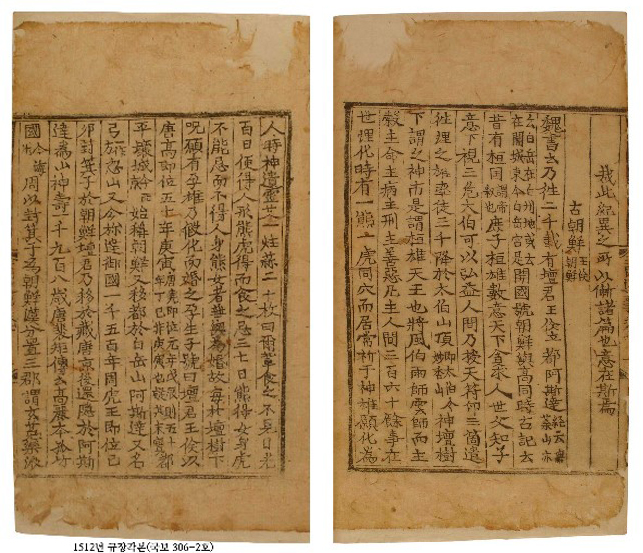"(Translation) 2019 王儉朝鮮"의 두 판 사이의 차이
(→Student Translation : Hector Sanchez) |
|||
| 28번째 줄: | 28번째 줄: | ||
| − | ===''Student Translation : Hector Sanchez''=== | + | ==='''Student Translation : Hector Sanchez'''=== |
The old records say: “In the past there was the state of Hwan. A secondary son, Hwanung had intended many times to come down from Heaven and pursue the world of humans. His father, knowing his son thought about coming down, inspected the three Mountains and Mount T’aebaek [and of them said that it] could be used to greatly benefit the people in there. Then, he gave him three Heavenly symbols [regalia] and dispatched him to go rule them. | The old records say: “In the past there was the state of Hwan. A secondary son, Hwanung had intended many times to come down from Heaven and pursue the world of humans. His father, knowing his son thought about coming down, inspected the three Mountains and Mount T’aebaek [and of them said that it] could be used to greatly benefit the people in there. Then, he gave him three Heavenly symbols [regalia] and dispatched him to go rule them. | ||
2019년 7월 11일 (목) 22:37 기준 최신판
| Primary Source | ||
|---|---|---|
 |
Title | |
| English | ||
| Chinese | ||
| Korean(RR) | ||
| Text Details | ||
| Genre | ||
| Type | ||
| Author(s) | ||
| Year | ||
| Source | ||
| Key Concepts | ||
| Translation Info | ||
| Translator(s) | Participants of 2019 JSG Summer Hanmun Workshop (Intermediate Training Group) | |
| Editor(s) | ||
| Year | 2019 | |
Original Script
Translation
Student Translation : Hector Sanchez
The old records say: “In the past there was the state of Hwan. A secondary son, Hwanung had intended many times to come down from Heaven and pursue the world of humans. His father, knowing his son thought about coming down, inspected the three Mountains and Mount T’aebaek [and of them said that it] could be used to greatly benefit the people in there. Then, he gave him three Heavenly symbols [regalia] and dispatched him to go rule them. [Hwan]ung led a following of three thousand coming down to the top of T’aebaek Mountain. The [area] beneath the altar tree was called the Sacred City. Upon this, he was called Hwanung the Heavenly King. With the Chief of Wind, and the commanders of rain and clouds, he ruled over grains, fate, illness, punishment, and the good or evil of all, and ruled over the people’s more than three hundred sixty human affairs.
In those days there was a bear and a tiger who together lived at a cave. They regularly prayed to Hwanung hoping that they would be turned into people. One time, the god presented them with one stick of wormwood and 20 cloves of garlic and said: “If you two eat this and do not see the sunlight for a hundred days, then you will achieve human form.” The bear and the tiger got and ate this and avoided for 21 days the sun, and the bear achieved a female body. The tiger could not avoid [light] and did not get a human form. As for the bear woman, she lacked one with whom to get married and thus frequently, beneath the altar tree prayed [regarding her] wish to be pregnant. [Hwan]ung then temporarily changed [into a human] and married her. When pregnant she gave birth to a son and named him Tan’gun Wanggŏm.
In the 50th year [after the] enthronement of King Gao [Yao] of Tang, a Kyŏngin year, he set his capital at Pyŏngyang Fortress and began calling [his kingdom] Chosŏn.
He also moved the capital to Asadal (Paekaksan,) also named Kŭmmidal (Kungholsan.) He ruled the kingdom for 1500 years.
In the Kimyo year after the enthronement of King Hu [Wu] of Zhou, [the Zhou] enfeoffed Kija in Chosŏn. Tan’gun then moved to Changdangkyŏng and later returned and hid at Asadal, where he became a mountain deity and lived [a long life] until he was 1908 years old.
- Discussion Questions:
(YO) -Well done! It was long text and you did a very careful translation.
-How should we understand Samwi 三危 as in Samwi T’aebaek? In the added note by the Kuksa p’yŏnch’an wiwŏnhoe 국사편찬위원회 (National Institute of Korean History) supposed that Samwi Mountain might be modern Kuwŏl Mountain 九月山 in Hwanghae Province, based on the commentary in the Chewang un’gi 帝王韻紀 and the record included in the Sinjŭng Tongguk yŏji sŭngnam 新增東國輿地勝覽 (42), which state Samwi is another name of Asadal Mountain (which appears later in this passage). Then the double-line commentary in the text image says “太白山今妙香山” (T’aebaek Mountain is Myohyang Mountain now). This image is from the 1512 edition (known as Chungjong imsin pon 中宗壬申本 or Chŏngdŏk pon 正德本) of the Samguk yusa. If we trust these sources, Samwi and T’aebaek are both names of mountains, the former being modern Kuwŏl Mountain and the latter, Myohyang Mountain. See http://db.history.go.kr/item/level.do?itemId=sy (in Kwŏn 1, under "Ki'i" 紀異).
-As for 風伯雨師雲師, it is accepted to interpret them as names of three deities. (So, Wind Chief, Rain Master, Cloud Master, something like that?)